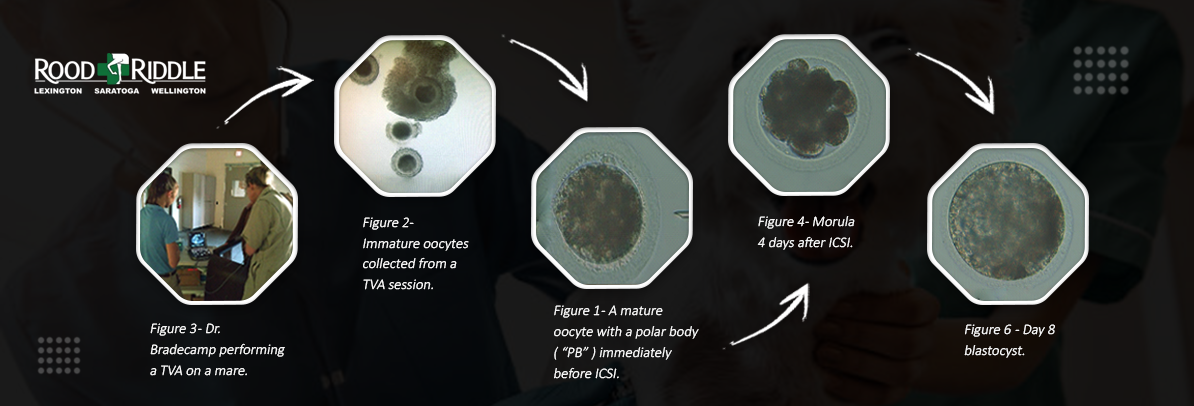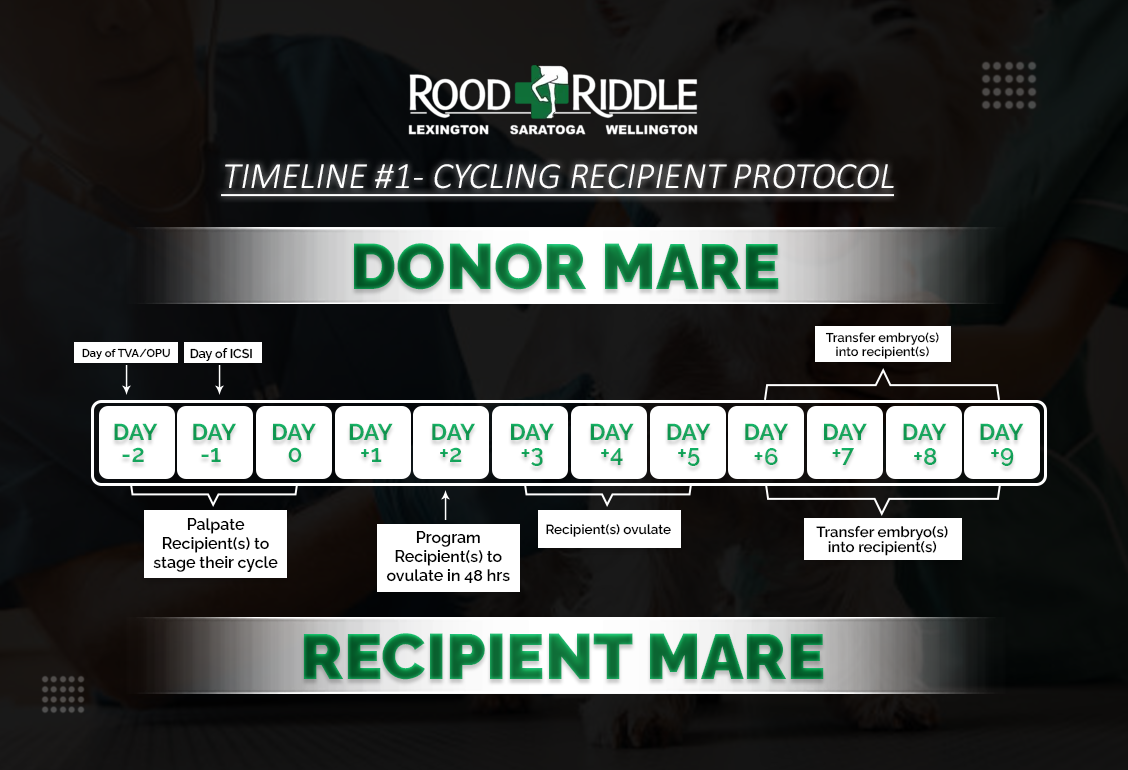Frequently Asked Questions
Equine Intra-Cytoplasmic Sperm Injection (ICSI)
What is ICSI?
What are the steps involved?
What are the indications for ICSI?
When is the best time to collect oocytes?
How frequently can you collect oocytes via TVA?
What are the success rates?
What if a client wants to collect a mature oocyte from a dominant-stimulated follicle (DSF)?
How do I set up my recipient (surrogate) mares for an in vitro produced (IVP) embryo?
Is there a difference in success rates between using cycling and non-cycling recipients?
Is there a difference in success rates between “fresh” and “frozen” embryos?
What are the estimated costs?
Intra-Cytoplasmic-Sperm Injection (ICSI) involves injecting a mature oocyte with a single spermatozoon to generate a blastocyst for subsequent transfer or freezing. The entire process, from the time oocytes are collected to the time a viable blastocyst could be created, takes 12 days.
Transvaginal aspirations (TVAs, aka, ovum pick-up) are performed under standing sedation to collect oocytes (“eggs”) from mares’ ovaries. This procedure is typically done on an out-patient basis. The oocytes are then matured in an incubator for 30 hours. Those that mature are fertilized via ICSI and then incubated for 7-10 days to generate blastocysts.
There are myriad reasons, but the most common ones we encounter are:
- Chronic sub- or in-fertility secondary to cervical, uterine or oviductal disease
- Limited semen availability
- Inability to collect embryos via traditional methods of breeding and flushing 7-8 days after ovulation
- Repeated ovulation failure
- Preservation of valuable genetic lines
When the mare has the most follicles between 5 and 20mm in size, preferably at least 12 of them. This is usually when the mare is out of heat or during the transition period. Some studies have shown oocytes collected from a dominant-stimulated follicle (DSF) have ~70% chance of forming a blastocyst. However, these require added resources and planning. In addition, a recent study from our laboratory (published in JAVMA, October 2022) showed a higher number of follicles when the mare was in diestrus as compared to estrus, but there was no difference in blastocyst rates between the two stages of estrous.
Usually every 2-4 weeks, but some mares may need longer to develop enough follicles on their ovaries to maximize success rates.
They vary, but average rates calculated from our laboratory and four commercial ICSI laboratories are:
- Average oocyte recovery rate = 60% (i.e., >1 oocyte collected from every 2 follicles aspirated)
- Average oocyte maturation rate = 55% of the collected oocytes
- Average cleavage rate = 65% per injected oocyte
- Average blastocyst rate = 15-20% per injected oocyte
- Average transfer rate = 65% per blastocyst
- Average blastocyst per TVA session = >1.00
- Example
o Mare has 20 follicles → 12 oocytes collected → 7 oocytes mature → 1 blastocyst
As mentioned above, some studies have showed improved blastocyst rates from oocytes collected from a DSF. The requirements for DSF oocyte collection are:
- At least one follicle greater than or equal to 35 mm
- Good uterine edema (subjective score 2 or 3)
- Relaxed cervix
- Does not have a detectable CL
- Give 1 mL Sucromate IM and 2.5 mL hCG IV 22-24 hours before the anticipated time of the aspiration and schedule the aspiration accordingly
- Please note some ICSI labs do not accept DSF-oocytes or require they be shipped in a special media; please contact the ICSI lab for more information.
Protocol :
IVP embryos require a different and tighter window of synchrony than “regular” embryos, with highest success rates being reported when they are transferred into recipient mares that have ovulated 3-5 days prior. Ideally, we want to transfer FOUR (4) days after the recipient ovulates. On the following pages are protocols for both Cycling and Non-Cycling recipients
- Should receive an embryo 3-5 days after her ovulation
- The recipient should be induced to ovulate 5-7 days after the donor mare’s aspiration (or 1-3 days after ICSI)
- The day of ovulation should be confirmed
- Please see TIMELINE #1 at the end of this document
- Qualifications
o No follicles greater than 20 mm in size
o No detectable CL and/or serum progesterone < 1 ng/mL - Treatment o Days 1, 2 and 3
- Please see TIMELINE #2
Non-Cycling Recipient :
- Estradiol-17beta (3.33 mg/mL), 3 mL (10 mg), IM, once daily
o Days 4, 5 and 6
- Progesterone (50 mg/mL), 3 mL (150 mg), IM, once daily
At this time, the only difference is non-cycling recipient mares should be supplemented with progesterone until at least 42 days, if not up to 120 days when the fetoplacental unit begins to produce progestins to maintain the pregnancy. Our laboratory presented a study in 2021 in which we did not see a difference in pregnancy rates 7- and 35-days post-transfer between cycling and non-cycling recipients.
Our laboratory has not observed a difference over the past 3 years. Instead, recipient quality and synchrony appear to be more important factors in establishing a pregnancy and producing a live foal than whether or not the embryo was frozen.
Blastocyst = A viable embryo that can either be transferred into a suitable recipient mare or frozen for transfer at a later time.
Cleavage = Term describing active cell division, which is a sign of early embryonic development; in horses, cleavage should occur by Day 5 after ICSI.
Day 0 = Day of ICSI
ICSI = intra-cytoplasmic sperm injection; involves fertilization of a mature oocyte with a single spermatozoon
IVP = in vitro-produced; used to describe how the embryo was generated; i.e., IVP embryo
Freezing = there are two methods to “freeze” embryos: (1) vitrification, which is the most common method used in our lab and the commercial ICSI labs we commonly use; and (2) slow freeze, which is more common in Europe. When thawed properly, we do not notice a difference in transfer rates between vitrified and slow-frozen embryos.
TVA = Trans-vaginal aspiration. Also known as ovum pickup (OPU), this method is used to collect oocytes from mares’ ovaries for subsequent ICSI.






